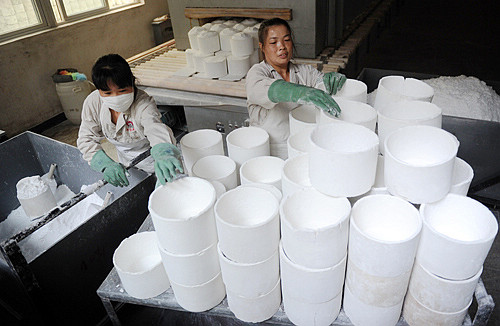|
 |
|
POWERFUL BOOST: Workers of Ganzhou Dahuaxin New Materials Co. Ltd. process rare earth metals. The Chinese Government has vowed to take steps to streamline the industry (ZHOU KE) |
On May 19, the State Council released Guidelines to Promote Sustainable and Sound Development of the Rare Earth Industry, delivering a strong boost to the fragmented industry.
Rare earth elements, a collection of 17 elements, are among the most sought-after materials for modern manufacturing. Their unique magnetic and phosphorescent properties make them vital ingredients in sophisticated hi-tech devices like batteries, magnets, wind turbines, cellphones, electric cars and flat-screen televisions. However, mining and smelting the elements are difficult and costly.
The world now relies on China to meet more than 90 percent of its needs for rare earth metals, even though the country's reserves account for about only one third of the global total. However, over-expansion has left China in a dire situation with sharply reduced reserves, illegal mining, environmental damage and disorder in exports.
"These acute woes have cast an ominous shadow over the sector's growth prospect," said the State Council. "That has placed an onus on the country to streamline the fragmented sector and stabilize its growth pattern."
As a result, the Chinese Government pledged to keep rare earth mining under control and continue with the current export quota system. It also vowed to suspend issuance of new licenses for rare earth production and launch a crackdown on illegal mining and mineral smuggling,
Prior to this, the Ministry of Land and Resources in March ordered to cap nationwide rare earth production under 93,800 tons for 2011, slightly up 5.15 percent from the previous year. Besides, the Ministry of Commerce (MOFCOM) in late 2010 announced to set an export quota at 14,446 tons for the first half of 2011, down 11.4 percent from a year ago.
The conservation efforts are fully warranted. China may run out of rare earth metals in 15 to 20 years if the current wave of rampant domestic mining continues," said Chao Ning, Director of the Industrial Products Section of MOFCOM Foreign Trade Department. "While China is exhausting its limited resources, many Western countries are leaving their mines untouched."
As traditional mining techniques are destructive to forests, soil and farmland, the State Council's circular said the government will phase out outdated and polluting mining methods and encourage enterprises to upgrade their technologies.
Also, for the first time, the country made plans to create a national strategic reserve of rare earth. Without government approval, no company is allowed to explore deposits in these reserved zones. But affected enterprises could receive government subsidies as compensation.
Moreover, policymakers also pledged hikes in the resource tax on rare earth, an effort to put prices at a reasonable level. In April, the Ministry of Finance ordered increases to the resource tax rates of 60 yuan ($9.2) per ton for light rare earths and 30 yuan ($4.6) for mid-heavy rare earths.
"This move will benefit the industry over the long term, though it causes cost inflation to manufacturers," said Zhang Anwen, Deputy Secretary-General of the Chinese Society of Rare Earths
After flooding the world with cheap rare earths for more than a decade, China is seeking to regain its pricing power of the commodity, he said.
Heng Kun, a senior analyst with the Essence Securities Co. Ltd., said the guidelines sent a clear signal that China is determined to push forward a sweeping industry reshuffle, despite international clamor that accuses China of hoarding these resources.
"The key is ensuring the adequate implementation of those measures," said Wang Guozhen, a rare earth expert and former deputy director of China Non-Ferrous Engineering and Research Institute (ENFI). "The efforts may be watered down as local governments bump up output."
In 2009, China produced 120,000 tons of rare earth, well above the government-set ceiling of 82,300 tons.
Consolidation underway
A focus of the government measures was to consolidate the highly fragmented industry and sharpen its competitive edge.
| 